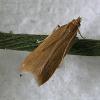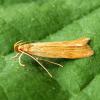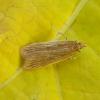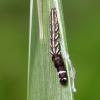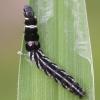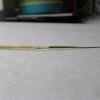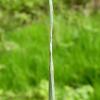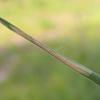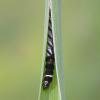35.031 Helcystogramma rufescens (Haworth, 1828)
Status and Distribution
Widespread and locally common throughout much of England, Ireland and the Channel Islands. More local in northern England, Wales and Northern Ireland, while in Scotland it appears to be restricted to a few sites in south-west, a little more widespread in western Scotland and a single record from the Outer Hebrides. Apparently absent from the Isle of Man.
Provisional map
Foodplant and Larval Feeding Signs
Arrhenatherum elatius (false oat-grass), Poa spp. (meadow grasses), Dactylis glomerata (cock's-foot grass), Brachypodium sylvaticum (false brome), B. pinnatum (tor-grass), Calamagrostis epigejos (wood small-reed), Schedonorus (Festuca) arundinaceus (tall fescue), Holcus mollis (creeping soft-grass) and a Milium sp (millet).
Habitat
Rank, often ungrazed or lightly grazed grassland on downland, coastal areas, roadside verges, damp fields, canal banks, woodland rides and rarely moorland.
Finding the Moth
Larva: spins the grass blade into a roll, open at each end, changing rolls several times before pupation. Fenestrates the leaf from within often causing the tip of the grass blade to appear white.
Adult: can be disturbed during the day and is attracted to light.
Similar Species
In the past, the separation of this species from H. lutatella was based on the presence or absence of blackish stigmata on the forewing. This was proved to be unreliable by Heckford and Sterling (1999) and subsequent examination of Museum specimens from various localities demonstrate that some H. rufescens can have between one to three dark brown scales in the middle of the forewing at one-third and two-thirds.
Heckford and Sterling gave the key identification features as follows:
H. lutatella - the forewings are grey-brown to brown coloured and lack the ochreous coloured veins of H. rufescens. The labial palps are white above and below (without brown scales) and the hindwing of the female pale to dark grey.
In H. rufescens the forewing is ochreous (or veins ochreous with brown scaling), the outer margins of the labial palpus has brown scales and the hindwing of the female is whitish.
Separating the larva of these two species is more readily achieved in early instars. In H. lutatella, the abdominal segments one and two are black with a reddish or reddish brown sclerotized plate on each anteriorly, smaller on segment one, confined to the dorsum and rounded with small lateral extensions. In H. rufescens, these two segments are black with the sclerotized plates dark olive (early instar) becoming pale brown in later instars. The plate on segment one is very small consisting of a narrow, linear band, hardly broadening about the dorsum.
Microscopic examination of small, pale, worn specimens is recommended in extreme southern coastal areas where the shape of the sclerite of tergite 1 and 2 in both sexes are distinctly horse-shoe shaped in H. rufescens and boomerang shaped in H. lutatella (see link to the genitalia in the Images section above). Only differences in the female genitalia are of any practical use in separating the two species (Heckford and Sterling, 1999, full reference in the Publications: Published Papers section of this site).
Single brooded from mid-June to late August with occasional, possibly second brood moths from September to early October.
On 13th September 2019, twelve near final instar larvae were swept from moorland grass on Islay (VC102), Scotland, at 100m amsl (M Harvey pers. comm.). A few previous mid-August to mid-October reports of larvae have been restricted to the southern half of the British Isles.

